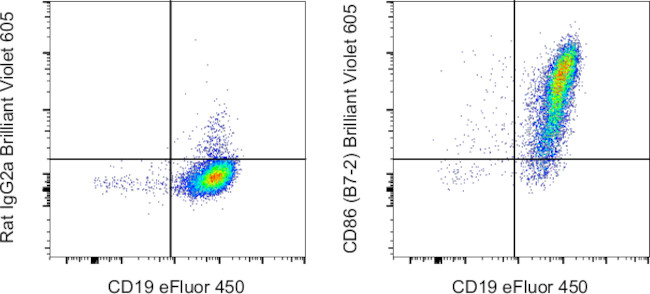Search Thermo Fisher Scientific
Invitrogen
CD86 (B7-2) Monoclonal Antibody (GL1), Brilliant Violet™ 605, eBioscience™
图: 1 / 1
CD86 (B7-2) Antibody (406-0862-82) in Flow

产品信息
406-0862-82
种属反应
宿主/亚型
分类
类型
克隆号
偶联物
激发/发射光谱
形式
浓度
纯化类型
保存液
内含物
保存条件
运输条件
RRID
产品详细信息
Description: The GL1 monoclonal antibody reacts with mouse CD86, an ~80 kDa surface receptor also known as B7-2. CD86 and CD80 are members of the B7 family of costimulatory molecules. CD86 is expressed at low level on B cells, macrophages, and dendritic cells and is upregulated on B cells through a variety of surface stimuli including the BCR complex, CD40 and some cytokine receptors. CD86 is also expressed by activated mouse T cells and thioglycolate-elicited peritoneal cells. In addition to CD80 (B7-1), CD86 is a counter-receptor for the T cell surface molecules CD28 and CD152 (CTLA-4). This interaction plays a critical role in T-B crosstalk, T cell costimulation, autoantibody production and Th2-mediated Ig production. The kinetics of upregulation of CD86 upon stimulation, supports its major contribution during the primary phase of an immune response.
Applications Reported: This GL1 antibody has been reported for use in flow cytometric analysis.
Applications Tested: This GL1 antibody has been tested by flow cytometric analysis of mouse splenocytes. This may be used at less than or equal to 0.06 µg per test. A test is defined as the amount (µg) of antibody that will stain a cell sample in a final volume of 100 µL. Cell number should be determined empirically but can range from 10^5 to 10^8 cells/test. It is recommended that the antibody be carefully titrated for optimal performance in the assay of interest.
Brilliant Violet™ 605 (BV605) is a tandem dye that emits at 605 nm and is intended for use on cytometers equipped with a violet (405 nm) laser. Please make sure that your instrument is capable of detecting this fluorochrome.
When using two or more Super Bright, Brilliant Violet™, Brilliant Ultra Violet™, or other polymer dye-conjugated antibodies in a staining panel, it is recommended to use Super Bright Complete Staining Buffer (Product # SB-4401-42) or Brilliant Stain Buffer™ (Product # 00-4409-75) to minimize any non-specific polymer interactions. Please refer to the datasheet for Super Bright Staining Buffer or Brilliant Stain Buffer for more information.
Light sensitivity: This tandem dye is sensitive to photo-induced oxidation. Please protect this vial and stained samples from light.
Fixation: Samples can be stored in IC Fixation Buffer (Product # 00-8222-49) (100 µL of cell sample + 100 µL of IC Fixation Buffer) or 1-step Fix/Lyse Solution (Product # 00-5333-54) for up to 3 days in the dark at 4°C with minimal impact on brightness and FRET efficiency/compensation. Some generalizations regarding fluorophore performance after fixation can be made, but clone-specific performance should be determined empirically.
Our internal testing suggests that Brilliant Violet™ 605 (BV605) is not compatible with methanol-based fixation.
Excitation: 407 nm; Emission: 605 nm; Laser: Violet Laser.
BRILLIANT VIOLET™ is a trademark or registered trademark of Becton, Dickinson and Company or its affiliates, and is used under license. Powered by Sirigen™.
靶标信息
CD86 is one of two ligands (the other CD80) for CTLA4 and CD28. CD86 acts as costimulatory molecule in eliciting T-cell help during antigen presentation. Antigen presentation in the absence of sufficient co-stimulation involving CD86/CD80 can induce tolerance. CD80 appears to play a role distinct from CD80 in T helper cell differentiation. CD86 is a type I membrane protein that is a member of the immunoglobulin superfamily. The CD86 protein is expressed by antigen-presenting cells, and it is the ligand for two proteins at the cell surface of T cells, CD28 antigen and cytotoxic T-lymphocyte-associated protein 4. Binding of CD86 with CD28 antigen is a costimulatory signal for activation of the T-cell. Binding of CD86 with cytotoxic T-lymphocyte-associated protein 4 negatively regulates T-cell activation and diminishes the immune response. Alternative splicing results in two transcript variants encoding different isoforms of CD86. Additional transcript variants have been described for CD86, but their full-length sequences have not been determined. Diseases associated with CD86 dysfunction include gallbladder squamous cell carcinoma and myocarditis.
仅用于科研。不用于诊断过程。未经明确授权不得转售。
How to use the Panel Builder
Watch the video to learn how to use the Invitrogen Flow Cytometry Panel Builder to build your next flow cytometry panel in 5 easy steps.
篇参考文献 (0)
生物信息学
蛋白别名: Activation B7-2 antigen; B lymphocyte activation antigen B72; CD28 antigen ligand 2; CD86; early T cell costimulatory molecule-1; Early T-cell co-stimulatory molecule 1; Early T-cell costimulatory molecule 1; ETC-1; MGC34413; T-lymphocyte activation antigen CD86
基因别名: B7; B7-2; B7.2; B70; Cd28l2; Cd86; CLS1; ETC-1; Ly-58; Ly58; MB7; MB7-2; TS/A-2
UniProt ID: (Mouse) P42082
Entrez Gene ID: (Mouse) 12524




